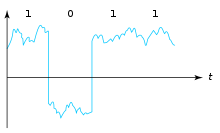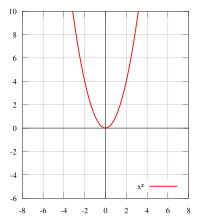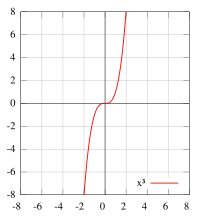Signal

Signal refers to both the process and the result of
In signal processing, a signal is a function that conveys information about a phenomenon.[1] Any quantity that can vary over space or time can be used as a signal to share messages between observers.[2] The IEEE Transactions on Signal Processing includes audio, video, speech, image, sonar, and radar as examples of signals.[3] A signal may also be defined as any observable change in a quantity over space or time (a time series), even if it does not carry information.[a]
In nature, signals can be actions done by an organism to alert other organisms, ranging from the release of plant chemicals to warn nearby plants of a predator, to sounds or motions made by animals to alert other animals of food. Signaling occurs in all organisms even at cellular levels, with
Another important property of a signal is its entropy or information content. Information theory serves as the formal study of signals and their content. The information of a signal is often accompanied by noise, which primarily refers to unwanted modifications of signals, but is often extended to include unwanted signals conflicting with desired signals (crosstalk). The reduction of noise is covered in part under the heading of signal integrity. The separation of desired signals from background noise is the field of signal recovery,[5] one branch of which is estimation theory, a probabilistic approach to suppressing random disturbances.
Engineering disciplines such as electrical engineering have advanced the design, study, and implementation of systems involving
Definitions
Definitions specific to sub-fields are common:
- In electromagnetic wavethat carries information.
- In signal processing, signals are analog and digital representations of analog physical quantities.
- In information theory, a signal is a codified message, that is, the sequence of states in a communication channel that encodes a message.
- In a communication system, a transmitter encodes a message to create a signal, which is carried to a receiver by the communication channel. For example, the words "Mary had a little lamb" might be the message spoken into a telephone. The telephone transmitter converts the sounds into an electrical signal. The signal is transmitted to the receiving telephone by wires; at the receiver it is reconverted into sounds.
- In telephone networks, signaling, for example common-channel signaling, refers to phone number and other digital control information rather than the actual voice signal.
Classification
Signals can be categorized in various ways. The most common[
A second important distinction is between discrete-valued and continuous-valued. Particularly in digital signal processing, a digital signal may be defined as a sequence of discrete values, typically associated with an underlying continuous-valued physical process. In digital electronics, digital signals are the continuous-time waveform signals in a digital system, representing a bit-stream.
Signals may also be categorized by their spatial distributions as either point source signals (PSSs) or distributed source signals (DSSs).[2]
In Signals and Systems, signals can be classified according to many criteria, mainly: according to the different feature of values, classified into analog signals and digital signals; according to the determinacy of signals, classified into deterministic signals and random signals; according to the strength of signals, classified into energy signals and power signals.
Analog and digital signals

Two main types of signals encountered in practice are analog and digital. The figure shows a digital signal that results from approximating an analog signal by its values at particular time instants. Digital signals are quantized, while analog signals are continuous.
Analog signal
An analog signal is any
The term analog signal usually refers to
Any information may be conveyed by an analog signal; often such a signal is a measured response to changes in physical phenomena, such as sound, light, temperature, position, or pressure. The physical variable is converted to an analog signal by a transducer. For example, in sound recording, fluctuations in air pressure (that is to say, sound) strike the diaphragm of a microphone which induces corresponding electrical fluctuations. The voltage or the current is said to be an analog of the sound.
Digital signal

A digital signal is a signal that is constructed from a discrete set of
Alternatively, a digital signal may be considered to be the sequence of codes represented by such a physical quantity.
With digital signals, system noise, provided it is not too great, will not affect system operation whereas noise always degrades the operation of
Digital signals often arise via
Energy and power
According to the strengths of signals, practical signals can be classified into two categories: energy signals and power signals.[14]
Energy signals: Those signals' energy are equal to a finite positive value, but their average powers are 0;
Power signals: Those signals' average power are equal to a finite positive value, but their energy are infinite.
Deterministic and random
Deterministic signals are those whose values at any time are predictable and can be calculated by a mathematical equation.
Random signals are signals that take on random values at any given time instant and must be modeled stochastically.[15]
Even and odd
An even signal satisfies the condition
or equivalently if the following equation holds for all and in the domain of :
An odd signal satisfies the condition
or equivalently if the following equation holds for all and in the domain of :
Periodic
A signal is said to be periodic if it satisfies the condition:
or
Where:
= fundamental time
= fundamental frequency.
A periodic signal will repeat for every period.
Time discretization

Signals can be classified as
A continuous-time signal is any
Amplitude quantization
If a signal is to be represented as a sequence of digital data, it is impossible to maintain exact precision – each number in the sequence must have a finite number of digits. As a result, the values of such a signal must be quantized into a finite set for practical representation. Quantization is the process of converting a continuous analog audio signal to a digital signal with discrete numerical values of integers.
Examples of signals
Naturally occurring signals can be converted to electronic signals by various sensors. Examples include:
- Motion. The motion of an object can be considered to be a signal and can be monitored by various sensors to provide electrical signals.[16] For example, radar can provide an electromagnetic signal for following aircraft motion. A motion signal is one-dimensional (time), and the range is generally three-dimensional. Position is thus a 3-vector signal; position and orientation of a rigid body is a 6-vector signal. Orientation signals can be generated using a gyroscope.[17]
- Sound. Since a sound is a vibration of a medium (such as air), a sound signal associates a pressure value to every value of time and possibly three space coordinates indicating the direction of travel. A sound signal is converted to an electrical signal by a microphone, generating a voltage signal as an analog of the sound signal. Sound signals can be sampled at a discrete set of time points; for example, compact discs (CDs) contain discrete signals representing sound, recorded at 44,100 Hz; since CDs are recorded in stereo, each sample contains data for a left and right channel, which may be considered to be a 2-vector signal. The CD encoding is converted to an electrical signal by reading the information with a laser, converting the sound signal to an optical signal.[18]
- primary colors.
- Videos. A video signal is a sequence of images. A point in a video is identified by its two-dimensional position in the image and by the time at which it occurs, so a video signal has a three-dimensional domain. Analog video has one continuous domain dimension (across a scan line) and two discrete dimensions (frame and line).
- Biological membrane potentials. The value of the signal is an electric potential (voltage). The domain is more difficult to establish. Some cells or organelles have the same membrane potential throughout; neurons generally have different potentials at different points. These signals have very low energies, but are enough to make nervous systems work; they can be measured in aggregate by electrophysiology techniques.
- The output of a thermocouple, which conveys temperature information.[1]
- The output of a pH meter which conveys acidity information.[1]
Signal processing

Signal processing is the manipulation of signals. A common example is signal transmission between different locations. The embodiment of a signal in electrical form is made by a
Signals and systems
In electrical engineering (EE) programs, signals are covered in a class and field of study known as signals and systems. Depending on the school, undergraduate EE students generally take the class as juniors or seniors, normally depending on the number and level of previous linear algebra and differential equation classes they have taken.[19]
The field studies input and output signals, and the mathematical representations between them known as systems, in four domains: time, frequency, s and z. Since signals and systems are both studied in these four domains, there are 8 major divisions of study. As an example, when working with continuous-time signals (t), one might transform from the time domain to a frequency or s domain; or from discrete time (n) to frequency or z domains. Systems also can be transformed between these domains like signals, with continuous to s and discrete to z.
Signals and systems is a subset of the field of mathematical modeling. It involves circuit analysis and design via mathematical modeling and some numerical methods, and was updated several decades ago with dynamical systems tools including differential equations, and recently, Lagrangians. Students are expected to understand the modeling tools as well as the mathematics, physics, circuit analysis, and transformations between the 8 domains.
Because mechanical engineering (ME) topics like friction, dampening etc. have very close analogies in signal science (inductance, resistance, voltage, etc.), many of the tools originally used in ME transformations (Laplace and Fourier transforms, Lagrangians, sampling theory, probability, difference equations, etc.) have now been applied to signals, circuits, systems and their components, analysis and design in EE. Dynamical systems that involve noise, filtering and other random or chaotic attractors and repellers have now placed stochastic sciences and statistics between the more deterministic discrete and continuous functions in the field. (Deterministic as used here means signals that are completely determined as functions of time).
EE taxonomists are still not decided where signals and systems falls within the whole field of signal processing vs. circuit analysis and mathematical modeling, but the common link of the topics that are covered in the course of study has brightened boundaries with dozens of books, journals, etc. called "Signals and Systems", and used as text and test prep for the EE, as well as, recently, computer engineering exams.[20]
Gallery
-
A signalman sends a semaphore message from a Pearl Harbor Control Tower, c. 1960.
-
A Finnish distant signal at the western approach to Muhos station is displaying Expect Stop.
-
A woman hailing a cab is sending a signal of availability to be picked up.
-
A flare is a common means to signal during dark or smoke-filled conditions.
See also
- A Mathematical Theory of Communication – 1948 article on theory of communication by Claude Shannon
- Current loop – a signaling system in widespread use for process control
- Signal-to-noise ratio
Notes
References
- ^ a b c d
Roland Priemer (1991). Introductory Signal Processing. World Scientific. p. 1. ISBN 978-9971509194. Archivedfrom the original on 2013-06-02.
A signal is a function that conveys information about the behavior of a system or attributes of some phenomenon.
- ^ a b
Chakravorty, Pragnan (2018). "What Is a Signal? [Lecture Notes]". IEEE Signal Processing Magazine. 35 (5): 175–177. S2CID 52164353.
Consequently, a signal, represented as a function of one or more variables, may be defined as an observable change in a quantifiable entity.
- ^
"Aims and scope". IEEE Transactions on Signal Processing. IEEE. Archivedfrom the original on 2012-04-17.
- ISBN 978-0387755809. Archivedfrom the original on 2013-06-02.
To put it very generally, a signal is any time-varying physical quantity.
- ^
T. H. Wilmshurst (1990). Signal Recovery from Noise in Electronic Instrumentation (2nd ed.). CRC Press. pp. 11 ff. ISBN 978-0750300582. Archivedfrom the original on 2015-03-19.
- ^ "Digital signals". www.st-andrews.ac.uk. Archived from the original on 2017-03-02. Retrieved 2017-12-17.
- ^ "Analog vs. Digital - learn.sparkfun.com". learn.sparkfun.com. Archived from the original on 2017-07-05. Retrieved 2017-12-17.
- ISBN 1401840302. Archived from the originalon 2017-12-17.
A digital representation can have only specific discrete values
- ISBN 9780131873742. Archivedfrom the original on 2016-05-20.
- ISBN 9780080527147. Archived from the originalon 2017-12-17.
A digital signal is a complex waveform and can be defined as a discrete waveform having a finite set of levels
- ^ "Digital Signal". Archived from the original on 2019-04-02. Retrieved 2016-08-13.
- ISBN 9780521809269.
- ISBN 9788121930956.
A digital signal is a special form of discrete-time signal which is discrete in both time and amplitude, obtained by permitting each value (sample) of a discrete-time signal to acquire a finite set of values (quantization), assigning it a numerical symbol according to a code ... A digital signal is a sequence or list of numbers drawn from a finite set.
- )
- )
- ^
For an example from robotics, see
K Nishio & T Yasuda (2011). "Analog–digital circuit for motion detection based on vertebrate retina and its application to mobile robot". In Bao-Liang Lu; Liqing Zhang & James Kwok (eds.). Neural Information Processing: 18th International Conference, Iconip 2011, Shanghai, China, November 13–17, 2011. Springer. pp. 506 ff. ISBN 978-3642249648. Archivedfrom the original on 2013-06-02.
- ^
For example, see M. N. Armenise; Caterina Ciminelli; Francesco Dell'Olio; Vittorio Passaro (2010). "§4.3 Optical gyros based on a fiber ring laser". Advances in Gyroscope Technologies. Springer. p. 47. ISBN 978-3642154935. Archivedfrom the original on 2013-06-02.
- ^
The optical reading process is described by Mark L. Chambers (2004). CD & DVD Recording for Dummies (2nd ed.). John Wiley & Sons. p. 13. ISBN 978-0764559563. Archivedfrom the original on 2013-06-02.
- ISBN 978-0-07-147578-5. Archivedfrom the original on 2020-01-22. Retrieved 2017-09-11.
- ISBN 978-0073380681.
Further reading
- Hsu, P. H. (1995). Schaum's Theory and Problems: Signals and Systems. McGraw-Hill. ISBN 0-07-030641-9.
- Lathi, B.P. (1998). Signal Processing & Linear Systems. Berkeley-Cambridge Press. ISBN 0-941413-35-7.





















